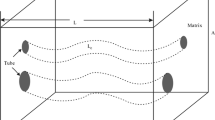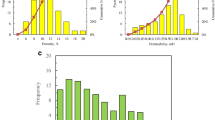Abstract
The resistivity experimental measurements of 36 core samples, which were drilled from low permeability reservoirs of southwest China, illustrate that the saturation exponents are not agminate, but vary from 1.627 to 3.48; this leads to a challenge for water saturation estimation in low permeability formations. Based on the analysis of resistivity experiments, laboratory nuclear magnetic resonance (NMR) measurements for all 36 core samples, and mercury injection measurements for 20 of them, it was observed that the saturation exponent is proportional to the proportion of small pore components and inversely proportional to the logarithmic mean of NMR T 2 spectrum (T 2lm). For rocks with high proportion of small pore components and low T 2lm, there will be high saturation exponents, and vice versa. The proportion of small pore components is characterized by three different kinds of irreducible water saturations, which are estimated by defining 30, 40 and 50 ms as T 2 cutoffs separately. By integrating these three different kinds of irreducible water saturations and using T 2lm, a technique of calculating the saturation exponent from NMR logs is proposed and the corresponding model is established. The credibility of this technique is confirmed by comparing the predicted saturation exponents with the results from the core analysis. For more than 85 % of core samples, the absolute errors between the predicted saturation exponents from NMR logs and the experimental results are lower than 0.25. Once this technique is extended to field application, the accuracy of water saturation estimation in low permeability reservoirs will be improved significantly.








Similar content being viewed by others
References
G.E. Archie, The electrical resistivity log as an aid in determining some reservoir characteristics. TAME 146, 54–61 (1942)
M.R.J. Wyllie, A.R. Gregory, L.W. Gardner, Elastic waves velocities in heterogeneous and porous media. Geophysics 21(1), 41–70 (1956)
Z.H. Chu, J. Gao, L.J. Huang, L.Z. Xiao, Principles and methods of geophysical logging (Part II) (Petroleum Industry Pressure, Beijing, 2007), pp. 224–326
H.M. Karter, H.K. Mostafa, An approach for minimizing errors in computing effective porosity in reservoir of shaly nature in view of Wyllie–Raymer–Raiga relationship. J. Petrol. Sci. Eng. 77, 386–392 (2011)
Schlumberger Well Services, Log interpretation charts. (Schlumberger Well Services, 1986), pp. 1–112
Y.J. Shi, G.R. Li, J.Y. Zhou, Study on litho-electric character and saturation model of argillaceous low-permeability sandstone reservoir. Well Logging Technol 32(3), 203–206 (2008)
Y.M. Wang, M. M. Sharma, A network model for the resistivity behavior of partially saturated rocks. Paper G presented at the 29th SPWLA Annual Logging Symposium (1988)
Z.Q. Mao, C.G. Zhang, C.Z. Lin, J. Ouyang, Q. Wang, C.J. Yan, The effects of pore structure on electrical properties of core samples from various sandstone reservoirs in Tarim basin. Paper LL presented at the 36th SPWLA Annual Logging Symposium (1995)
Z.Q. Mao, T.D. Tan, C.Z. Lin, Q. Wang, The laboratory studies on pore structure and electrical properties of core samples fully-saturated with brine water. Acta Petrolei Sinica 18(3), 51–55 (1997)
G.R. Coates, L.Z. Xiao, M.G. Primmer, NMR logging principles and applications (Gulf Publishing Company, USA, Houston, 2000), pp. 42–78
S. Anferova, V. Anferov, D.G. Rata, B. Blümich, J. Arnold, C. Clauser, P. Blümler, H. Raich, A mobile NMR device for measurements of porosity and pore size distributions of drilled core samples. Concepts in Magnetic Resonance, Part B. Magn. Reson. Eng. 23B(1), 26–32 (2004)
X.P. Liu, X.X. Hu, L. Xiao, Effects of pore structure to electrical properties in tight gas reservoirs: an experimental study, SPE 150926 (2012)
R. Ausbrooks, N.F. Hurley, A. May, D.G. Neese, Pore-size distributions in vuggy carbonates from core images, NMR, and capillary pressure, SPE 56506 (1999)
S.A. Shedid, A novel technique for the determination of microscopic pore size distribution of heterogeneous reservoir rock, SPE 107705 (2007)
N.C. Wardlaw, Y. Li, Pore-throat size correlation from capillary pressure curves. Transp. Porous Media 2(1987), 597–614 (1994)
R. Askarinezhad, A new statistical approach to pore/throat size distribution of porous media using capillary pressure distribution concept. J. Petrol. Sci. Eng. 75(1–2), 100–104 (2010)
S.H. Chen, G. Ostroff, D.T. Georgi, Improving estimation of NMR log T 2cutoff value with core NMR and capillary pressure measurements, SCA-9822, pp. 1–12 (1998)
L. Xiao, Z.Q. Mao, Y. Jin, Calculation of irreducible water saturation (S wirr) from NMR logs in tight gas sands. Appl. Magn. Reson. 42(1), 113–125 (2012)
C. Staley, Magnetic resonance digital image analysis and permeability of porous media. Appl. Phys. Lett. 51(15), 1146–1148 (1987)
C. Straley, C.E. Morriss, W.E. Kenyon, NMR in partially saturated rocks: laboratory insights on free fluid index and comparison with borehole logs. Paper CC presented at the 32nd SPWLA Annual Logging Symposium (1991)
C.E. Morriss, J. Maclnnis, R. Freedman, Field test of an experimental pulsed nuclear magnetism tool. Paper GGG presented at the 34th SPWLA Annual Logging Symposium (1993)
Acknowledgments
The authors thanks for the supporting of the Fundamental Research Funds for the Central Universities, China (No. 2011YXL009) to this research work.
Author information
Authors and Affiliations
Corresponding author
Rights and permissions
About this article
Cite this article
Xiao, L., Mao, Zq., Li, Gr. et al. Estimation of Saturation Exponent from Nuclear Magnetic Resonance (NMR) Logs in Low Permeability Reservoirs. Appl Magn Reson 44, 333–347 (2013). https://doi.org/10.1007/s00723-012-0366-1
Received:
Revised:
Published:
Issue Date:
DOI: https://doi.org/10.1007/s00723-012-0366-1




